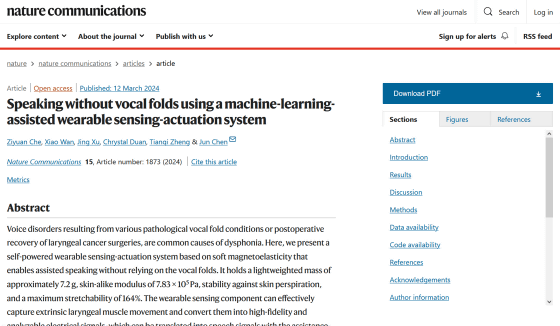A ``throat patch'' will be developed that will enable people with vocal cord damage or paralysis to speak.

by Jun Chen Lab at UCLA
A research team at the University of California, Los Angeles, has developed a ``throat patch'' that allows people who have lost the use of
Speaking without vocal folds using a machine-learning-assisted wearable sensing-actuation system | Nature Communications
https://www.nature.com/articles/s41467-024-45915-7

New throat patch can turn muscle movements into speech
https://medicalxpress.com/news/2024-03-throat-patch-muscle-movements-speech.html
New self-powered throat patch could help people speak without cord vocals | Live Science
https://www.livescience.com/health/new-self-powered-throat-patch-could-help-people-speak-without-vocal-cords
Speech is one of the primary ways humans communicate, but anyone can develop dysphonia due to a variety of pathological reasons, with 29.9% of the population experiencing dysphonia at least once in their lifetime. There is a possibility. Additionally, 7% of people currently experience a voice disorder, and in some cases they are forced to take time off from work or quit their jobs.
Jun Chen , the paper's senior author and an assistant professor of bioengineering at the University of California, Los Angeles, gave a lecture for several hours on how to speak without using your vocal cords. He said that he came up with the idea.
Since the 19th century, scientists have known that the magnetic properties of some hard metals change when exposed to mechanical stress. In a 2021 paper , Chen et al.'s research team reported that the magnetic properties of a soft material with micro magnets embedded in thin silicon change when it is deformed.
In a new study, Chen et al. used this silicone material with embedded micromagnets to create a ``throat patch'' that generates electrical signals that can be converted into speech from muscle movements associated with speech. The patch has a five-layer structure, with a central layer of silicon and micromagnets generating a magnetic field in response to muscle movement, and two layers of copper wire coils sandwiching this between converting magnetic changes into electrical signals. Masu. By wrapping these three layers in a flexible silicone material, it becomes a small patch with enough elasticity to stick on your throat.

This is the patch actually developed by Chen et al.

by Jun Chen Lab at UCLA
It looks like this when you put it on your throat.

by Jun Chen Lab at UCLA
The research team conducted a demonstration with eight subjects who had no speech problems, and had them speak while the patch was attached to their throats, and trained a machine learning algorithm to convert throat movements into speech. The subjects repeated short phrases and sentences such as ``Merry Christmas'' and ``I hope your experiments are going well'' 100 times while walking or standing still.
A trained machine learning algorithm was able to convert electrical signals generated by throat movements into correct speech with 95% accuracy. This was reportedly confirmed both when subjects actually made vocalizations and when they moved their throats without making any vocalizations.
Although the results of this study are promising, the patch was still in its early stages of development, the sounds played had to be pre-recorded, and the test subjects were limited to people without speech disorders. However, Chen is hopeful that future algorithm improvements will improve the patch's ability to translate text, allowing it to convert muscle movements into speech without pre-recording audio.
Related Posts:
in Science, Posted by log1h_ik







